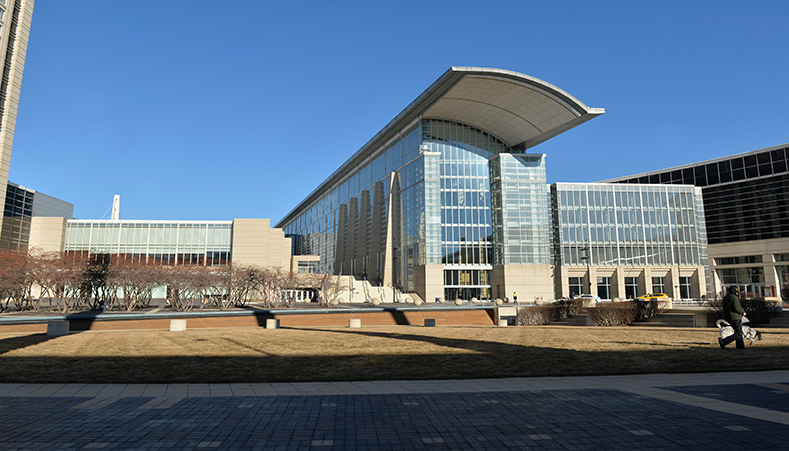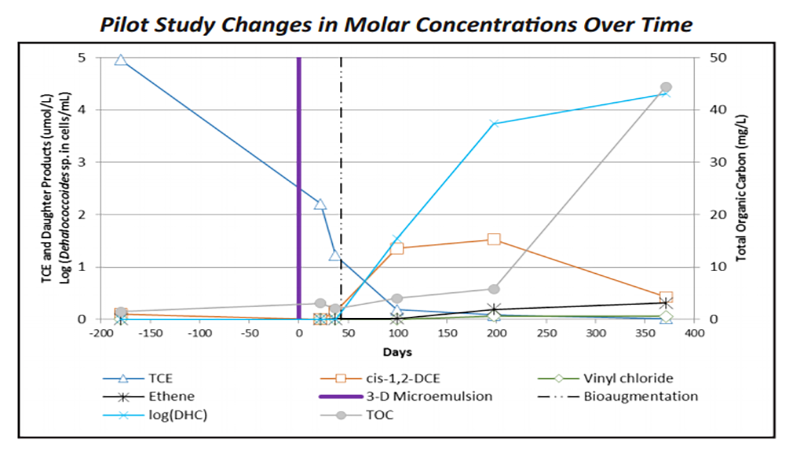RegenOx® and 3-D Microemulsion® Injections Treat VOC Impacted Soils
PCE Contamination at Former Dry Cleaning Site in Northern California Remediated
Project Highlights
- PCE soil concentrations of up to 16,095 ug/kg in the hot spot area
- After initial ISCO application, ERD was used to continue VOC concentration reduction
- Latest sampling event reported concentrations below clean-up target levels
- No further remediation needed on-site
Project Summary
In 2007, VOCs including (PCE) and related compounds including (TCE), (cis-DCE), and vinyl chloride (VC) were detected in soil and groundwater samples collected at a site in Northern California. A comprehensive field investigation conducted under the Regional Water Quality Control Board identified a distinct VOC-impacted soil area behind the former dry cleaner. Site characterization work identified the presence of VOCs including PCE with soil concentrations of up to 16,095 ug/kg in the hot spot area. A combined technology remediation approach was
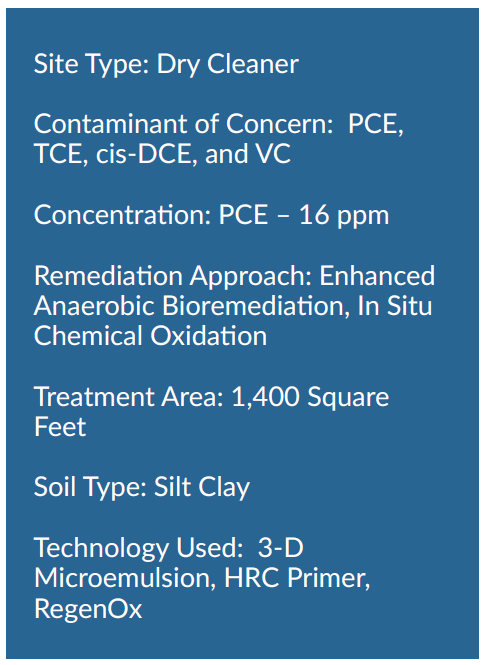
implemented on-site including injections of RegenOx®, 3-D Microemulsion® and HRC® Primer. At the most recent sampling event, approximately 2.5 years post-application, the maximum detected concentrations of PCE and related VOCs was 420 ug/kg and all soil sample results were below the Soil Cleanup Levels. These data suggest that the combination of in situ chemical oxidation (ISCO) with RegenOx, followed by enhanced reductive dechlorination with 3-D Microemulsion has been highly effective in reducing VOC concentrations in soil.
Remediation Approach
Three rounds of ISCO injections with RegenOx were applied on-site to treat the vadose zone soils. After the first round of injection, PCE was detected in soil samples collected in this area at maximum concentrations of 2,000 ug/kg, which, while substantially lower than initial concentrations indicated a need for further treatment. Enhanced reductive dechlorination (ERD) was performed by injecting 3-D Microemulsion and HRC Primer into vadose zone soil to treat PCE and related daughter products. The products were injected into 33 borings in the hot spot area with the treatment interval between 3 feet and 17 feet below ground surface. The most recent soil samples indicated a VOC concentration reduction to below the Regional Water Board’s soil to groundwater leaching ESLs (upon which the Site Cleanup Levels listed in the Site Cleanup Order were based). As a result, residual VOC concentrations in soil in the hot spot area do not appear to present a significant source for leaching to underlying groundwater. Continued groundwater monitoring being performed. No further remediation is required in this area.
Technology Description
RegenOx is an advanced chemical oxidation technology that destroys contaminants through powerful, yet controlled chemical reactions and not through biological means. This product maximizes in situ performance while using a solid alkaline oxidant that employs a sodium percarbonate complex with a multi-part catalytic formula.
3-D Microemulsion factory emulsified is an engineered electron donor material that offers a novel 3-stage electron donor release
profile, pH neutral chemistry and is delivered on-site as a factory–emulsified product.
HRC Primer is a less viscous version of the standard Hydrogen Release Compound (HRC) product. It is a thinner, water-like compound that is typically injected into an aquifer where it releases lactic acid at a rate faster than standard HRC (several weeks), but at a slower, more controlled rate than dispersing aqueous simple sugar solutions or straight lactic acid (several days).
PlumeStop® Brownfield Site Remediation Reduces cVOCs by up to 97% in 78 Days
1m 17s reading time
Rapid Treatment and Precise Project Execution Keeps Large Chicago Redevelopment on Track
Project Highlights
- Monitoring wells indicated up to a 97% reduction in cVOCs 78 days post treatment
- Development schedule of urban Chicago high-rise hotel and sports arena development kept on track with effective remediation implementation
- PlumeStop® provided a long-term means of addressing contaminant mass flux migrating from untreated areas
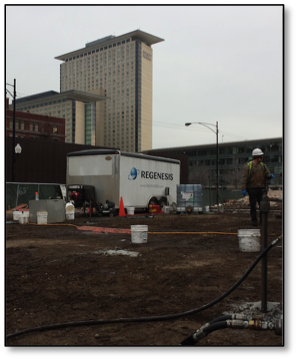
Project Summary
Located in the heart of downtown Chicago, this brownfield site was impacted by chlorinated solvents used for a range of manufacturing activities over many decades. Redevelopment is underway to construct a multi-million dollar urban event center and sports arena with adjacent hotel and retail space planned.
The affected site stood in the way of the planned redevelopment activities. REGENESIS® Remediation Services (RRS) was contracted to treat the contaminated area. An effective combination of PlumeStop®, Hydrogen Release Compound (HRC®) and a bioaugmentation culture, BioDechlor INOCULUM Plus® (BDI Plus), was applied to achieve the remediation targets. At 78 days post-application, the two primary treatment performance wells observed up to 97% reduction in total cVOCs achieving site remediation goals.
Technology Description
PlumeStop Liquid Activated Carbon™ is composed of very fine particles of activated carbon (1-2μm) suspended in water through the use of unique organic polymer dispersion chemistry. Once in the subsurface, the material behaves as a colloidal biomatrix binding to the aquifer matrix, rapidly removing contaminants from groundwater, and enhancing permanent contaminant biodegradation.
HRC is a controlled release, electron donor material, that when hydrated is specifically designed to produce a controlled release of lactic acid. The newly available lactic acid is critical for the production of hydrogen to fuel anaerobic biodegradation processes in soil and groundwater.
Bio-Dechlor INOCULUM Plus is an enriched natural microbial consortium containing species of Dehalococcoides sp. (DHC). This microbial consortium has since been enriched to increase its ability to rapidly dechlorinate contaminants during in situ bioremediation processes.
Results
By the first monthly monitoring event, the performance wells met the remediation objective and continued to maintain cVOC reduction throughout the monitoring period.
Combined Remedies Approach Reduces CVOCs up to 97% in 78 Days
Project Highlights
- Downtown Chicago site planned for multi-million dollar redevelopment
- Manufacturing operations caused CVOC impacts in groundwater of up to 6500 ug/L
- Redevelopment schedule required effective treatment with timely implementation
- Monitoring wells indicated up to 97% reduction of CVOCs 78 days post treatment
1m 18s reading time
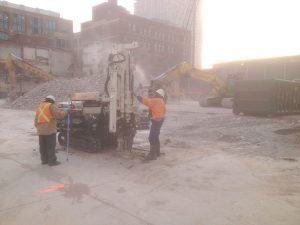
Project Summary
This site in downtown Chicago, was impacted by chlorinated solvents used in various historic manufacturing activities. DCE and TCE concentrations were recorded up to 7,440 µg/L in a sand formation over clay. As the site was to be redevelopment as a hotel and sports arena, and any programme delays would be extremely costly, the client needed a quick and permanent remedy to achieve the stringent target levels (of: total VOC MCL 567 µg/L and TCE MCL 242 µg/L) REGENESIS successfully remediated the groundwater to below target levels within the tight time window.
Treatment
The designed volumes of PlumeStop, HRC, and BDI Plus were successfully applied within the defined treatment zones (see map right) during the application event. A combined volume of 265 m3 of PlumeStop, HRC and BDI Plus was injected via 138 direct push injection points.
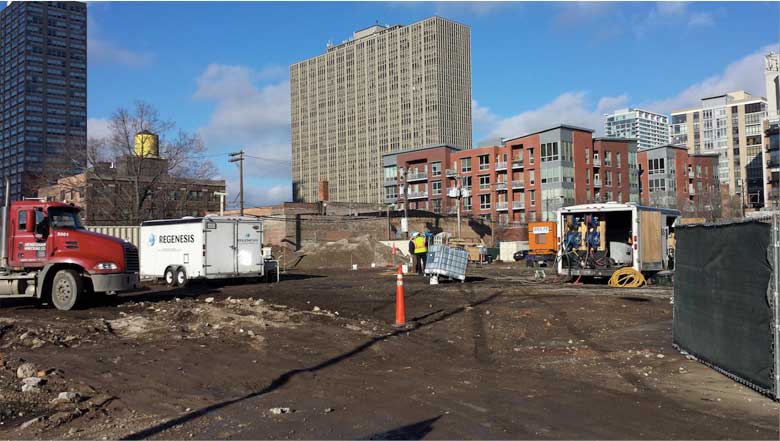
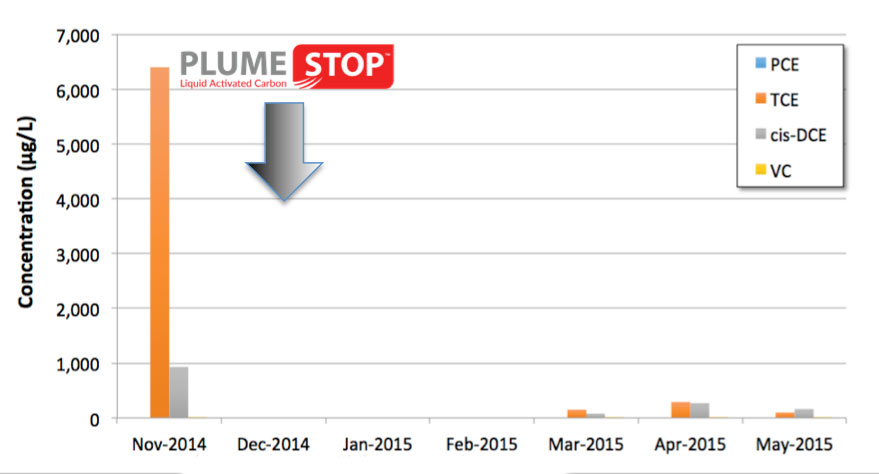
Results
78 days post-application, the two key validation wells (AW 3-3 and AW 3-2) observed 80% and 97% reduction in total CVOCs. BDI Plus was used to facilitate the bioaugmentation. As a result, the DHC sp. count and functional genes of the anaerobic metabolic pathways increased significantly from baseline measurements, as determined by QuantArray® analysis. This means that not only contaminant sorption is occurring, but that biodegradation is happening as well. The second and third monitoring round (at 108 and 138 days) confirm the production of breakdown products, indicating that enhanced reductive dechlorination (ERD) is ongoing. Regulatory sign-off is applied for.
What’s Special?
- Unsupported by PlumeStop, bioremediation would not have been an option for a site with such a tight programme. This project shows that accelerated bioremediation using Plumestop can compete with In Situ Chemical Oxidation on time
- The execution of this application was unique because of the tight project programme
- Rapid reduction in groundwater contamination: 80 – 97% from first sampling interval of the total solvents. The concentration levels in all wells are now compliant.
Technology Description
PlumeStop™ Liquid Activated Carbon™ is composed of very fine particles of activated carbon (1-2μm) suspended in water through the use of unique organic polymer dispersion chemistry. Once in the subsurface, the material behaves as a colloidal biomatrix binding to the aquifer matrix, rapidly removing contaminants from groundwater, and expediting permanent contaminant biodegradation.
HRC® is a controlled release, electron donor material, that when hydrated is specifically designed to produce a controlled release of lactic acid. The newly available lactic acid is critical for the production of hydrogen to fuel anaerobic biodegradation processes in soil and groundwater.
Bio-Dechlor INOCULUM® Plus is an enriched natural microbial consortium containing species of Dehalococcoides sp. (DHC). This microbial consortium has since been enriched to increase its ability to rapidly dechlorinate contaminants during in situ bioremediation processes.
Enhanced Reductive Dechlorination with Bioaugmentation Treats Source Area, Stops Plume Migration
Combined Remedy Source Treatment Applied at Florida Dry Cleaner
Project Highlights
- Aggressive source treatment to deplete the high-concentration PCE mass
- Plume treatment with a permeable reactive barrier to cut off the plume
- Low-impact direct-push injections in both areas
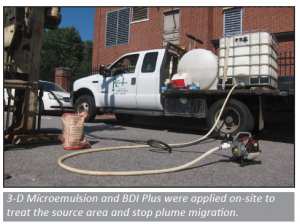
Project Summary
A former dry cleaner in an urban setting in central Florida was contaminated with a PCE plume that extended nearly 1,000 feet downgradient from the source. An extensive treatability test involving multiple emulsified vegetable oils and other electron donor technologies indicated that 3-D Microemulsion® would perform best at the site. An enhanced anaerobic bioremediation treatment was implemented in two areas – the source area near the dry cleaner and an area approximately 500 feet downgradient. A total of 13,900 gallons of 3-D Microemulsion was injected into 30 direct push points in the two areas. In addition, 97 liters of Bio-Dechlor INOCULUM Plus (BDI® Plus) bioaugmentation culture was injected to accelerate treatment results.
Remediation Approach
The injections were performed near the former dry cleaner to deplete the source mass and expedite a transition into natural attenuation monitoring. A plume treatment was implemented as a permeable reactive barrier approximately 500 feet downgradient to help mitigate the risk of additional downgradient migration. Injections were completed using direct-push technology.
Technology Description
3-D Microemulsion is an engineered electron donor technology that offers a novel 3-stage electron donor release profile pH-neutral chemistry, and unique subsurface distribution properties.
Bio-Dechlor INOCULUM Plus is a natural microbial consortium containing species of Dehalococcoides sp. (DHC). This microbial consortium has since been enriched to increase its ability to rapidly dechlorinate contaminants during in situ bioremediation processes.
Cost-Effective Remediation Plan Implemented at Active Texas Dry Cleaner
3-D Microemulsion® Reduces Chlorinated Solvent Contamination to Clean-Up Standards
Project Highlights
- Dual-phase extraction used to treat high level PCE in the source area.
- Enhanced Anaerobic Bioremediation selected as a cost-effective approach to treating migrating contamination.
- Majority of contamination reduced to clean-up standards; two low-level VC areas remain above desired limits.
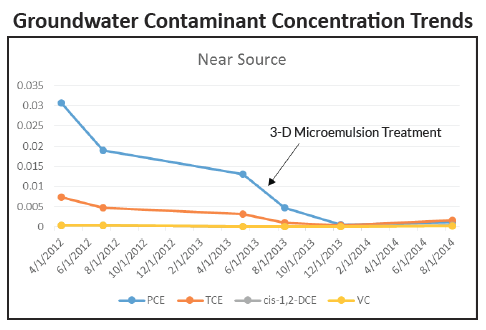
Project Summary
Dry cleaning operations resulted in a PCE release at a Texas dry cleaner. PCE concentrations at high at 95 mg/L were observed on-site. Aggressive clean-up measures were used in the form of dual-phase extraction of DNAPL and solvents in the source area. This resulted in nearly a two order-of-magnitude reduction in PCE concentrations in certain source wells. The second clean-up phase included expanding the system to treat contamination that had migrated out of the source area into the periphery of the groundwater plume.
Remediation Approach
Due to a limited budget for remediation, a cost-effective anaerobic bioremediation approach was selected due to the desire for a long-lasting solution that could also achieve low concentrations. 3-D Microemulsion and HRC Primer were injected along the migration centerline of the plume extending from just outside the source area to the toe of the plume. A second smaller treatment event was conducted in the vicinity of the former source area.
One year post-injection all solvent concentrations have dropped below clean-up standards with the exception of two low-level contamination areas. Recent treatment of the source area is starting to result in similar trends although there is not enough data yet to track remediation progress of the second injection event.
However, biostimulation alone through the addition of 3-D Microemulsion and HRC Primer appears to be very effective. Ongoing monitoring will occur followed by initiation of closure monitoring once all critical wells reach target levels.
Technology Description
3-D Microemulsion is an engineered electron donor material that offers a novel 3-stage electron donor release profile, pH neutral chemistry and is delivered on-site as a factory-emulsified product.
HRC Primer is a less viscous version of the standard Hydrogen Release Compound (HRC) product. It is a thinner, water-like compound that is typically injected into an aquifer where it releases lactic acid at a rate faster than standard HRC (several weeks), but at a slower, more controlled rate than dispersing aqueous simple sugar solutions or straight lactic acid (several days).
Regulatory Goals Met in 30 Days in Complex Industrial Dry Cleaner Plant Remediation
Project Highlights
- PCE contaminant concentrations met remediation goals within 30 days post-application
- No rebound post-application
- Remediation goals met for site closure submittal
1m 57s reading time
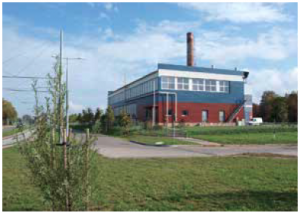
Project Summary
An industrial dry cleaning plant in West Allis, Wisconsin was equipped with multiple underground storage tanks (USTs) which stored the degreasing agent perchloroethylene (PCE). The UST releases date back to 50 years and created a treatment area of approximately 4,500 square feet. An in situ, combined remedies treatment approach was implemented onsite using a range of reagents including PlumeStop®, RegenOx®, Hydrogen Release Compound (HRC®) and BioDechlor INOCULUM Plus (BDI® Plus). This site was planned for future development, consequently the remediation approach was designed to achieve site closure by removing the residual source in the vadose zone and treating the deep groundwater plume.
Remediation Approach
Starting in the residual source area, in situ chemical oxidation (ISCO) was applied via soil mixing down to a depth of 7 ft. below ground surface. The ISCO program using RegenOx was designed to treat a total of 140 tons of PCE-impacted clay soil with initial concentrations measuring 169 mg/kg and a remediation goal of <14 mg/kg. To address the deep groundwater plume with PCE concentrations as high as 13,800 ppb, fast-acting, PlumeStop was applied through a series of deep injection wells approximately 80 to 95 ft. below ground surface. The use of PlumeStop allows remediation practitioners to quickly reduce concentrations over a wide-area with the long-term assurance of biodegradation. HRC and BDI Plus were co-applied with PlumeStop to enhance the biodegradation process.
Technology Description
RegenOx is an advanced chemical oxidation technology that destroys contaminants and maximizes in situ performance while using a solid alkaline oxidant that employs a sodium percarbonate complex with a multi-part catalytic formula.
PlumeStop is an innovative in situ remediation technology designed to rapidly reduce contaminant concentrations, stop migrating plumes, eliminate contaminant rebound, achieve stringent clean-up standards, and treat back-diffusing contaminants.
HRC is a controlled release, electron donor material, highly efficient for the production of dissolved hydrogen to fuel anaerobic biodegradation processes in soil and groundwater.
Bio-Dechlor INOCULUM Plus is a species of Dehalococcoides sp. (DHC), enriched to increase its ability to rapidly dechlorinate contaminants during in situ bioremediation processes.
Results
The ISCO application of RegenOx, and combined approach using HRC, BDI Plus and PlumeStop rapidly reduced contaminant concentrations to achieve the remediation goal in just 30 days post-application. As a result, the client has submitted for site closure. Using an innovative combined remedies approach provides environmental remediation professionals with an effective solution for treating sites that present multiple challenges including hard to treat contaminants, sites with lengthy history of impacted soils, difficult geologies, and time constraints.
Sequential Anaerobic and Aerobic Treatment of Chlorinated Solvents Achieves MCLs
Project Highlights
- All target compounds reduced to below Maximum Contaminant Level (MCLs) in onsite wells
- Anaerobic biodegradation using Hydrogen Release Compound (HRC®) treats tetrachloroethylene (PCE) and 1,1 dichloroethene (DCE) to below federal MCLs
- Aerobic biodegradation using ORC Advanced® treats vinyl chloride (VC) and 1,1-DCE to below MCLs
- ORC Advanced provided oxygen for a period of 15 months in the target treatment zone
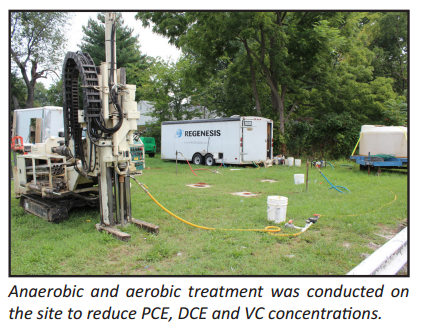
Project Summary
The site is located in the Coastal Plain of South Carolina and is a former light industrial facility. Baseline concentrations of total chlorinated VOCs – which included PCE, dechlorination daughter products, and 1,1- DCE – were as high as 2,000 μg/L in the near-source groundwater.
Initial groundwater treatment injected 2,400 pounds of HRC at the site using direct push technology. VOC concentrations in the target monitoring wells decreased to below federal MCLs for all contaminants except for VC and 1,1-DCE, which appeared to have stabilized between 10-15 μg/L and 7-30 μg/L, respectively.
In an attempt to meet the MCLs for all contaminants and attain regulatory closure, the treatment approach was shifted to aerobic bioremediation to accelerate degradation of residual VC and 1,1-DCE. This approach was based on evidence that aerobic biodegradation of daughter products such as VC can be much faster than anaerobic processes. The aerobic treatment involved injection of 1,360 pounds of ORC Advanced via direct push technology into 22 temporary points.
Technology Description
ORC Advanced is a proprietary formulation of food-grade, calcium oxy-hydroxide that produces a controlled-release of molecular oxygen to enhance aerobic biodegradation.
HRC is a controlled release, electron donor material that, when hydrated, is specifically designed to produce a controlled release of soluble lactate. The newly available lactic acid is highly efficient for the production of dissolved hydrogen to fuel anaerobic biodegradation processes in soil and groundwater.
Results
After initial groundwater treatment of HRC and following application of ORC Advanced, groundwater monitoring showed reductions in VC to below MCL except for periodic detections between 2-3 μg/L and reductions in 1,1-DCE to below the MCL of 7 μg/L onsite. The VOC concentrations and the dissolved oxygen levels demonstrated that ORC Advanced released oxygen for 15 months in the target treatment zone.
Bedrock Treatment Remediates NJ Manufacturing Facility
Project Highlights
- 3-D Microemulsion injections created 30-foot ROI in fractured bedrock
- TCE concentrations reduced through reductive dechlorination and daughter products reduced to ethene within 12-month study
- Pilot study results allowed for: full-scale design, maximized product ROI, minimized bedrock injection well drilling, and resulted in reduced overall project costs
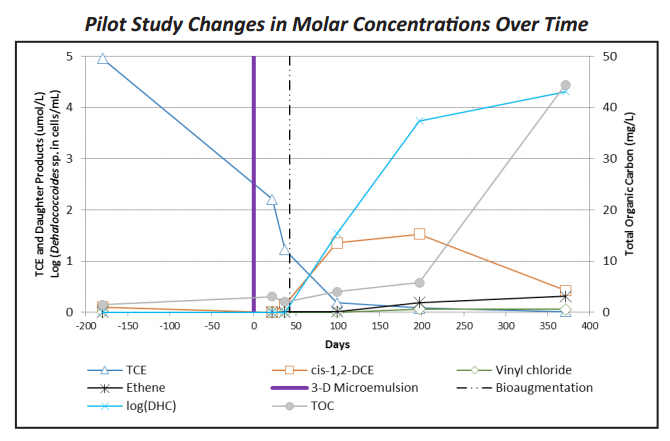
Project Summary
Previous manufacturing activities impacted a fractured bedrock aquifer with TCE. The plume migrated approximately 600 feet downgradient along fractures at 70-80 feet (shallow) and 105-115 feet (intermediate) below ground surface. Remediation at the site was planned as a phased approach including a source area pilot evaluation of enhanced reductive dechlorination, bioaugmentation, and radius of influence (ROI). A larger source area treatment and property boundary barrier was to be determined based upon the pilot study results.
The pilot study found that injection of 3-D Microemulsion was capable of initially influencing a 30-40 feet ROI based on visual (turbidity) and geochemical data. Over a 12-month period, TOC levels remained elevated at concentrations above 10 mg/L at a shallow well 20-feet away. At the two intermediate wells 40-feet away, TOC concentrations increased to >40 mg/L during this period. During this same pilot study period, TCE concentrations decreased, cis-1,2-DCE concentrations increased then attenuated, and VC and ethane concentrations increased. Bioaugmentation, occurring 6 weeks after the 3-D Microemulsion injection resulted in Dehalococcoides sp. populations that increased and sustained at elevated concentrations (104 cells/mL).
Remediation Approach
Injections of 3-D Microemulsion were introduced by packer into 2 injection wells across four 10-foot fracture intervals (60-115 feet bgs). Monitoring was conducted in two shallow bedrock wells at 70-80 feet bgs and two intermediate bedrock wells at 105-115 feet bgs. ROI monitoring was conducted at these four monitoring wells that were located 20 feet, 40 feet, and 55 feet away from the injection wells. Bioaugmentation was performed 6 weeks after 3-D Microemulsion injections. Full-scale treatment is planned, which will include a larger treatment in the source area and a downgradient barrier at the property boundary.
Technology Description
3-D Microemulsion is an engineered electron donor technology that offers a novel 3-stage electron donor release profile pHneutral chemistry, and unique subsurface distribution properties.
$1 Million Dollar Savings for Insurance Funded Remediation Project through Use of In Situ Chemical Oxidation and Enhanced Reductive Dechlorination
Combined Remedies Treat PCE Contamination at Active Dry Cleaner
Project Highlights
- Combined Remedies Approach (ISCO & ERD) implemented in unison near and below active dry cleaning facility.
- Sustained reduction of contaminants below clean-up levels observed 20 months after initial application.
- ISCO & ERD approach approximately $1,000,000 less expensive than proposed dual-phase extraction system option.
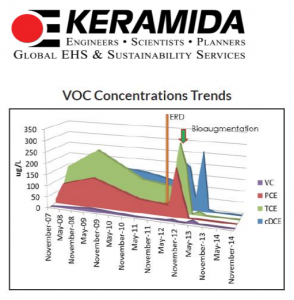
Project Summary
An active dry cleaner site located within a multi-use commercial development strip mall was impacted with high levels of PCE vapors. A subsequent investigation revealed groundwater impacts below the building and outside the building in a former filter storage area.
The original remediation plan involved a dual-phase extraction system with an estimated cost of approximately $1.3 million. An alternative approach consisting of in situ chemical oxidation (ISCO) coupled with enhanced reductive dechlorination (ERD) was proposed by KERAMIDA and ultimately selected by the funding source. To date, the ISCO/ERD approach has cost less than $200,000, including 2 years of monitoring and multiple indoor air/sub-slab vapor sampling events. $50,000 – $75,000 in additional remediation/monitoring is anticipated to achieve closure, resulting in an estimated total savings of $1,000,000 for this project being funded by insurance companies.
Remediation Approach
KERAMIDA developed a remediation work plan consisting of an ISCO injection into the permeable fill material directly beneath the floor of the dry cleaning space (Source Area), combined with a plume-wide ERD injection.
Injection points for both RegenOx® and 3-D Microemulsion® were installed inside the dry cleaner because there was insufficient clearance for the drilling equipment. The remainder of the ERD injection points outside the building were advanced using direct push technologies.
After approximately six months of post-injection monitoring, the data suggested insufficient bacteria were present to promote accelerated reductive dechloriation. Consequently, the bioaugmentation substrate BDI Plus was applied within the ERD treatment area. Graph to the right shows results from key well within this area.
As indicated above, the bioaugmentation substrate rapidly reduced the daughter products generated as a result of the initial electron donor injection. Two years of groundwater monitoring has been performed since the initial injection and CVOC concentrations in all of the wells, except one source-area well, are below the onsite remedial standard (groundwater migration to indoor airscreening level). In addition, two downgradient wells just outside the treatment area have slightly elevated TCE and VC concentrations.
A small supplemental injection is currently planned for the source area (to further reduce the VC concentration to below the screening level) and around the two off-site wells to reduce the minor cVOC concentrations to below residential levels so that deed restrictions are not required.
Technology Description
3-D Microemulsion is an engineered electron donor material that offers a novel 3-stage electron donor release profile, pH neutral chemistry and is delivered on-site as a factory-emulsified product.
RegenOx is an advanced chemical oxidation technology that destroys contaminants through powerful, yet controlled chemical reactions and not through biological means. This product maximizes in situ performance while using a solid alkaline oxidant that employs a sodium percarbonate complex with a multi-part catalytic formula.
Bio-Dechlor INOCULUM Plus is an enriched natural microbial consortium containing species of Dehalococcoides sp. (DHC). This microbial consortium has since been enriched to increase its ability to rapidly dechlorinate contaminants during in situ bioremediation processes.
After approximately six months of post-injection monitoring, the data suggested insufficient bacteria were present to promote accelerated reductive dechloriation. Consequently, the bioaugmentation substrate BDI Plus was applied within the ERD treatment area. Graph to the right shows results from key well within this area.
As indicated above, the bioaugmentation substrate rapidly reduced the daughter products generated as a result of the initial electron donor injection. Two years of groundwater monitoring has been performed since the initial injection and CVOC concentrations in all of the wells, except one source-area well, are below the onsite remedial standard (groundwater migration to indoor airscreening level). In addition, two downgradient wells just outside the treatment area have slightly elevated TCE and VC concentrations.
A small supplemental injection is currently planned for the source area (to further reduce the VC concentration to below the screening level) and around the two off-site wells to reduce the minor cVOC concentrations to below residential levels so that deed restrictions are not required.
About the Consultant

KERAMIDA Inc. is an engineering and consulting firm that serves industries, businesses, cities, and governments worldwide. They provide strategy and implementation services in: Sustainability, Green House Gases, Energy, Environmental Compliance, Remediation, Environmental Due Diligence, Brownfield Redevelopment, Plant Decommissioning, Health & Safety, Training, Risk Management, and ISO Management Systems. Established in 1988, KERAMIDA is headquartered in the historic Lockerbie Square district of Indianapolis, Indiana. The firm employs over 70 technical experts and support personnel in offices throughout the U.S., including Chicago, IL; Pittsburgh, PA; New York, NY; Los Angeles, CA, Sacramento, CA. KERAMIDA’s many principals have worked for over 25 years in the sustainability, environmental, health & safety, and remediation arenas, and are recognized leaders in their fields. Their engineers, scientists, and planners are renowned for delivering creative, integrated EHS solutions to a broad range of clients throughout the U.S. and abroad.
Combined Remedies Approach (Dual Phase Extraction, ISCO and ERD) Lead to Rapid Results on a Guaranteed Cost to Closure Project in Indiana
3- D Microemulsion, BDI Plus and RegenOx Reduce cVOC Concentrations
Project Highlights
- Guaranteed cost to closure project.
- ISCO coupled with dual-phase extraction was successful in reducing cVOC concentrations within the core source area.
- Plume-wide ERD injection resulted in meeting remedial goals within 18-20 months.
- Combined remedy approach (ISCO & ERD) accelerated the time to closure allowing project to be completed within budget
Project Summary
A plating plant in Batesville, Indiana was contaminated with chlorinated VOCs. A subsequent investigation identified a plume of TCE extending from the building approximately 250 feet down gradient (off-site and onto private property across a street).
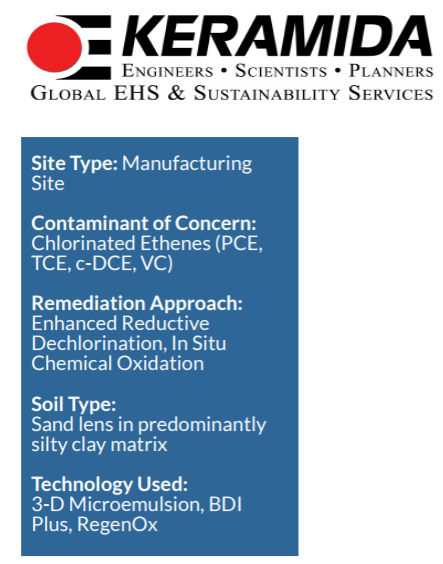
Remediation Approach
The initial remedial approach involved installation and operation of a dual-phase extraction (DPE) system throughout most of the plume area (26 extraction wells), which operated for approximately 1 ½ years. Approximately one year after the DPE system installation, a core area in situ chemical oxidation (ISCO) injection of RegenOx® was performed by KERAMIDA and Regenesis Remediation Services (RRS). ISCO combined with further operation of the DPE system was effective in additional reductions of cVOC concentrations in the groundwater. Upon conclusion of these efforts, the DPE system was shut down to allow for enhanced reductive dechlorination process to take place.
A successful enhanced reductive dechlorination (ERD) pilot test with 3-D Microemulsion® and BDI® Plus was performed around two off-site wells at the leading edge of the plume. Based on the success of this test, an ERD injection was performed in a newly-identified source area with outstanding results in the first six months. Consequently, the DPE system remained shut down and a full-scale ERD injection was performed in the core area of the plume.
Approximately 9 months after the full scale injections, a very small supplemental injection was performed in the off-site area where the pilot study was done and another in an area where no injection was performed. One year after the full-scale ERD injection, cVOC concentrations are below the target cleanup levels in all wells with the exception of two slightly elevated VC concentrations, which are expected to decrease shortly.
Technology Description
3-D Microemulsion is an engineered electron donor material that offers a novel 3-stage electron donor release profile, pH neutral chemistry and is delivered on-site as a factory-emulsified product.
RegenOx is an advanced chemical oxidation technology that destroys contaminants through powerful, yet controlled chemical reactions and not through biological means. This product maximizes in situ performance while using a solid alkaline oxidant that employs a sodium percarbonate complex with a multi-part catalytic formula.
Bio-Dechlor INOCULUM Plus is an enriched natural microbial consortium containing species of Dehalococcoides sp. (DHC). This microbial consortium has since been enriched to increase its ability to rapidly dechlorinate contaminants during in situ bioremediation processes.
About the Consultant
 KERAMIDA Inc. is an engineering and consulting firm that serves industries, businesses, cities, and governments worldwide. They provide strategy and implementation services in: Sustainability, Green House Gases, Energy, Environmental Compliance, Remediation, Environmental Due Diligence, Brownfield Redevelopment, Plant Decommissioning, Health & Safety, Training, Risk Management, and ISO Management Systems. Established in 1988, KERAMIDA is headquartered in the historic Lockerbie Square district of Indianapolis, Indiana. The firm employs over 70 technical experts and support personnel in offices throughout the U.S., including Chicago, IL; Pittsburgh, PA; New York, NY; Los Angeles, CA, Sacramento, CA. KERAMIDA’s many principals have worked for over 25 years in the sustainability, environmental, health & safety, and remediation arenas, and are recognized leaders in their fields. Their engineers, scientists, and planners are renowned for delivering creative, integrated EHS solutions to a broad range of clients throughout the U.S. and abroad.
KERAMIDA Inc. is an engineering and consulting firm that serves industries, businesses, cities, and governments worldwide. They provide strategy and implementation services in: Sustainability, Green House Gases, Energy, Environmental Compliance, Remediation, Environmental Due Diligence, Brownfield Redevelopment, Plant Decommissioning, Health & Safety, Training, Risk Management, and ISO Management Systems. Established in 1988, KERAMIDA is headquartered in the historic Lockerbie Square district of Indianapolis, Indiana. The firm employs over 70 technical experts and support personnel in offices throughout the U.S., including Chicago, IL; Pittsburgh, PA; New York, NY; Los Angeles, CA, Sacramento, CA. KERAMIDA’s many principals have worked for over 25 years in the sustainability, environmental, health & safety, and remediation arenas, and are recognized leaders in their fields. Their engineers, scientists, and planners are renowned for delivering creative, integrated EHS solutions to a broad range of clients throughout the U.S. and abroad.

 Americas
Americas Europe
Europe Français
Français Deutsch
Deutsch Italiano
Italiano Español
Español
